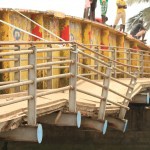
Today can report that chiefs of Akyem Kotoku Traditional Area in the Eastern region are up in arms against the Mahama-led National Democratic Congress (NDC) government.
The anger of the chiefs, the paper gathered, stems from government’s persistent failure to release a budgeted GHC140,000 for the rehabilitation of the bridge on the Birim River that links Akim Oda and its surrounding environs.
The chiefs cannot comprehend why the Mahama administration, the Eastern Regional Minister, District Chief Executive (DCE) of Akyemase District Assembly, Mr. Tom Dudu, and officials of the Bridge Maintenance Unit of Ghana Highways Authority and member of Parliament (MP) in the area, Mr. Opong Kusi, continue to pay lip-service to their complaint of the deteriorating condition of the bridge and the imminent threat it poses to lives in the area.
The chiefs told Today in an interview after a meeting in Akyem Ayirebi Palace on Friday, January 16, 2015 that they had formally informed the above authorities that the main bridge on River Birim that links Akim Oda and surrounding towns in the Eastern region to the Ashanti region was in a state of imminent collapse.
This notwithstanding, the chiefs noted that the current administration has neglected the steel bridge which serves as a rail and vehicular route for trains and vehicles across the Birim River to Eastern regional towns like Oda, Achiase, Aperade, Worakese and Assin Fosu in the Central region through to the Western and Ashanti regions.
A visit by Today to the bridge confirmed the precarious nature of the situation. For instance, our team observed that the metallic pillars of the bridge were fast rusting with disjointed metal bars, and pot holes also developing on the macadam. Another worrying situation was the fact that there were no streetlights across the bridge.
Today gathered that the rail line has been out of operation due to the collapse of the rail system.
It was further established that the bridge played a significant role in the lives of residents in the area.
Our team observed that a number of heavy articulated trucks with loaded logs plied the bridge.
The bridge also served as a route for transporting of logs in and around Akyem Oda to the Western region port of Takoradi.
The situation, Today can confirm, was worrying that any further delay in rehabilitating the bridge could bring economic activities to a halt.
Interestingly the Oda Senior High School is situated just about three kilometres away from the bridge.
The chiefs further stated that the ancient structure was the first ever road and bridge built in West Africa in the early 1950s.
According to them, the bridge is now embossed with a warning sign -‘Weak Bridge'- boldly displayed on either of its ends.
They pointed out that that the Ghana Highway Authority (GHA) has erected two concrete pillars on each end to prevent heavy duty trucks from using the bridge.
But in spite of the warning they noted that articulated and timber truck drivers continued to drive on the bridge.
Speaking in an interview with Today, residents of Akim Oda and Nkwanta stated that since the construction of the bridge about 50 years ago, it has not undergone any major rehabilitation works.
The structure sits on weak concrete pillars which are supported by a canopy of metal bars which put the entire bridge in a balance.
Pedestrians have no protection as they compete with on-coming vehicles for space as a result of the protective metal guards that have either broken or worn out.
A taxi driver who was awaiting his turn on the bridge told Today that, "It is scary using the bridge".
He blamed sawmill firms in the area for contributing to the deplorable nature of the bridge.
"Timber truck drivers which supply logs to sawmills have been warned to stop using the bridge but they won't listen," he claimed.
A cocoa farmer, Osei Koranteng, told the paper that "it is not safe for pedestrians and drivers.
Mr. Koranteng, therefore, called for the removal of the concrete pillars erected at the entrants of the bridge.
According to him, the pillars create inconvenience because when "you are behind it, you cannot see in-coming vehicles."